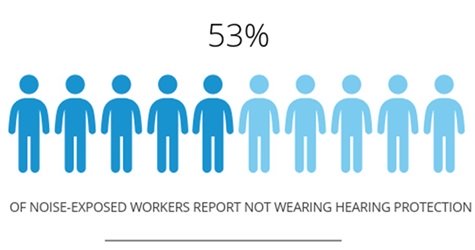An estimated 22 million workers in the United States face exposure to hazardous noise at work each year. And out of those 22 million workers, it’s predicted that over half of those do not use hearing protection when exposed to excessive noise according to a study from the National Institute of Occupational Safety and Health (NIOSH).

Share this blog with patients who may be at risk for noise-induced hearing loss. It offers valuable insights into the importance of workplace hearing protection and regular hearing screening, as well as how a structured hearing conservation program can help prevent long-term hearing damage.
Hearing Conservation Program
A hearing conservation program (HCP) is designed to prevent occupational hearing loss in noise-exposed employees. OSHA requires employers to monitor workplace noise levels if it exceeds 80 dB, whether the noise is continuous or intermittent. When employee exposure reaches or exceeds an 8-hour time-weighted average of 85 dB, employers must implement a hearing conservation program. This includes providing access to audiometric testing, which must consist of pure-tone air conduction and hearing threshold evaluations across key frequencies.
Hearing Conservation Program Best Practices
Based on OSHA regulations and best practices from NIOSH, there are a few core elements that contribute to an effective hearing conservation program:
- Measure Noise: Conduct regular noise surveys to identify hazardous noise levels and determine the need for hearing protection.
- Evaluate Needs and Control: Implement engineering and administrative controls to reduce noise exposure. Regular equipment maintenance, soundproofing, and employee scheduling adjustments are just a few ways an employer can take control and improve work conditions.
- Provide Hearing Protection: Provide appropriate hearing protection devices that are comfortable, properly fitted, and suitable for the noise environment. Individual fit testing ensures effectiveness for every employee.
- Fit Testing: Hearing protection fit testing measures how well the hearing protection reduces noise for an individual. This test ensures the protection is adequately working based on the individual’s ear anatomy.
- Require Routine Tests: Perform baseline and annual audiometric testing to monitor workers’ hearing over time and detect early signs of hearing loss. All employees must complete a baseline audiogram within six months of employment. Once tested, if a Standard Threshold Shift is 10 dB or more, a retest should be conducted within 30 days, and the employee must be notified in writing within 21 days if the shift is confirmed.
- Train and Educate: Educate employees on the risks of noise exposure, proper use and care of hearing protection, and the importance of hearing conservation.
- Keep Records: Maintain accurate records of noise exposure assessments, audiometric test results, and training activities. Noise exposure data must be kept for two years, and audiometric test records must be kept for the duration of employment for each employee.
- Reassess Regularly: Regularly review and assess the effectiveness of the HCP in place, making improvements based on data, feedback, and changes in workplace conditions.
How Does Your Audiologist Fit into Hearing Conservation Programs?
Audiologists play a central role in developing and maintaining Hearing Conservation Programs. Their expertise and education ensure programs are developed and implemented correctly. They are responsible for overseeing baseline and annual audiometric testing and interpreting the results. Audiologists also educate employees on the risk of noise exposure and train them on correctly using their hearing protection. Their collaboration with safety officers ensures hearing health is top of mind for employers.
Occupational hearing loss remains one of the most preventable yet prevalent workplace health concerns. By implementing a consistent hearing conservation program, grounded in OSHA 29 CFR 1910.95 standards, employers can protect their workforce from auditory damage. Regular occupational hearing screenings, combined with effective noise monitoring and employee training, form the backbone of a compliant program. Investing in hearing conservation is not just about compliance, it’s about preserving quality of life and enhancing workplace safety.
Laura Prigge, AuD is the Manager of Clinical Education and Training at GSI. Laura received her Doctorate of Audiology degree from AT Still University, a Master's of Arts in Audiology from UCONN and a Bachelor's of Science degree in Communication Disorders from Western Illinois University. Laura’s 20+ years of experience includes providing manufacturing support for a leading hearing aid manufacturer as well as technical audiology training and support for an international audiologic equipment company. Prior to that, she managed education and training at another hearing aid manufacturer and conducted audiologic evaluations on children, adults, and geriatric patients at a retail hearing center.